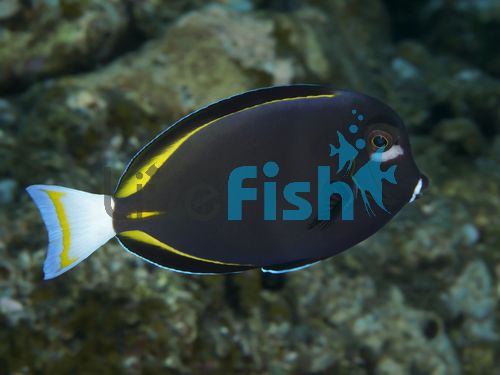Tang White Cheek Surgeon - Medium
The Whitecheek Surgeon Tang is a semi-aggressive species that show aggression if housed with other Tangs but is generally peaceful with most other fish.
The small white mark on its cheek is what gives it one of its common names. Its body colour is between dark blue to purple or black and its fins are dark blue with a light blue line around the edges. There are yellow lines that run along the rear of the top and bottom half of its body, thickening and meeting in front of the tail fin.
Tang White Cheek Surgeon
This species can become a valuable member of a reef community if aquarists follow the guidelines regarding water and tank buddies.
The Whitecheek Surgeon Tang is a semi-aggressive species that show aggression if housed with other Tangs but is generally peaceful with most other fish.
The small white mark on its cheek is what gives it one of its common names. Its body colour is between dark blue to purple or black and its fins are dark blue with a light blue line around the edges. There are yellow lines that run along the rear of the top and bottom half of its body, thickening and meeting in front of the tail fin.
Breeding in captivity is difficult, the size of a tank where it could be possible is bigger than most home aquarists will own. In the wild they form pair and spawn in open water, separating from their group and rising to the surface. Males are usually smaller than females, they may change colour during breeding as a warning to other males, and to attract a female mate.
White cheek Surgeon Tangs can be high maintenance and require a moderate level of care. They mix well with most other fish, apart from their own species and fish of similar size and feeding habits. They are ideal for a reef environment if they are kept well fed. Otherwise, they will start to nibble at some corals.
In the wild, this species can live for 30-45 years however this may be slightly less in captivity.
In their native habitat, juvenile Whitecheek Surgeon Tangs are shy and often hide amongst the coral. Adults are found on seaward reefs and lagoons in hard substrate areas. They can grow to about 8 inches (20.3 cm) in length.
It is found in the East Indian Ocean and both sides of the Pacific Ocean, from the Great Barrier Reef to the coast of Mexico.
Tank Recommendations for the Whitecheek Surgeon Tang
The Whitecheek Surgeon Tang is one of the more aggressive Tangs and it requires a larger tank than other Tangs of a similar size, so a tank of at least 125 gallons (473 litres) or larger is suitable.
As well as a large tank the Whitecheek Surgeon Tang needs plenty of open areas for swimming. It is best suited to a reef environment and is not a threat to invertebrates.
A suitable aquarium should have caves and overhangs for hiding and shelter. Rocky crevices created with live rock are preferable. Water needs to be oxygenated and of high quality, with fast, strong water movement.
Suitable Tank Buddies
White cheek Surgeon Tang is semi-aggressive. They can be aggressive to their own species and fish of a similar size. If attempting to co-habit Tangs, the tank should be a sufficient size and the Tangs should be introduced at the same time.
While they can co-habit with most other fish, they are best suited to sharing a tank with other aggressive species.
Usually Compatible
White cheek Surgeon Tangs can co-habit with most fish. Suitable tank buddies include Angels, Blennies, Chromis, Gobies, Lionfish, Scorpionfish, Pseudochromis and Wrasses.
Sometime Compatible
Caution is advised when introducing Tangs to tanks containing Batfish, Filefish, Sharks, Rays, Triggers, and other Tangs.
Rarely Compatible
White cheek Surgeon Tangs should not be housed with Seahorses/Pipefish
Feeding Your Whitecheek Surgeon Tang
White cheek Surgeon Tangs are herbivores. If meaty food such as mysis shrimp, brine shrimp and chopped seafood is placed in the aquarium they will eat it with other fish. This is a useful source of protein however their diet should mostly consist of marine algae and greens such as spirulina, broccoli, zucchini, and seaweed.
A tank with plenty of algae growth will allow them to graze while they are swimming. It is recommended to feed them 3-4 times per day.
| Scientific Name | Acanthurus Glaucopareius |
|---|




